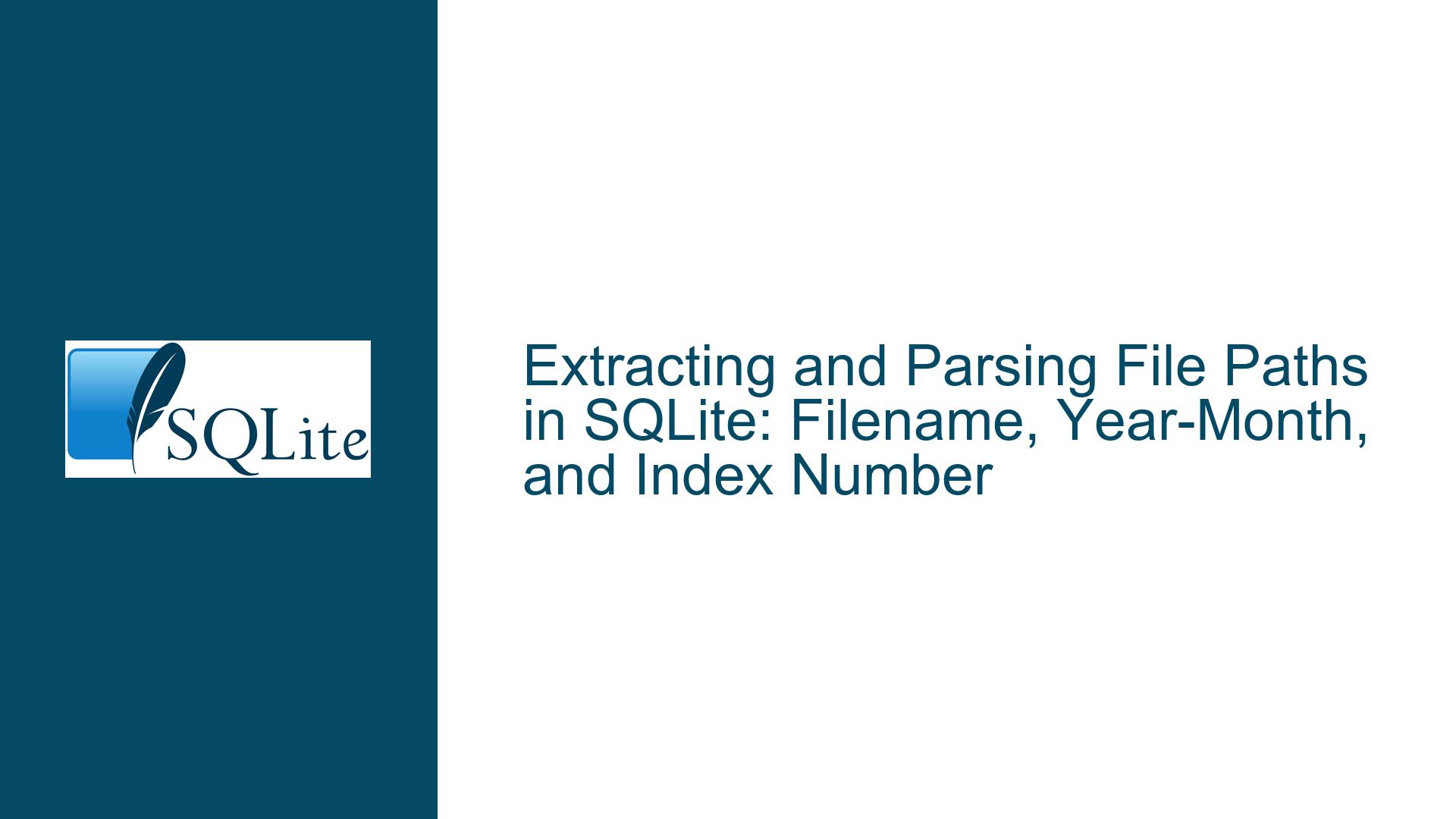Extracting and Parsing File Paths in SQLite: Filename, Year-Month, and Index Number
Understanding the File Path Parsing Requirements
The core issue revolves around parsing file paths stored in an SQLite database to extract specific components: the filename, the year-month segment, and the index number. The file paths follow a consistent structure, but the extraction requires handling substrings, delimiters, and dynamic lengths. The challenge lies in SQLite’s limited string manipulation functions, which do not include a native "last index of" function or advanced parsing capabilities. This necessitates creative use of existing functions like SUBSTR(), INSTR(), and IIF(), as well as leveraging Common Table Expressions (CTEs) for iterative processing.
The file paths are structured as follows:
D:\DOSYALAR\2021-07\0012090829\0012090829-202107-K-000000.zip
The goal is to extract:
- The filename (e.g.,
0012090829-202107-K-000000.zip). - The year-month segment (e.g.,
202107). - The index number (e.g.,
000000).
Challenges in SQLite String Manipulation
SQLite’s string manipulation capabilities are limited compared to other databases. For instance, there is no built-in function to find the last occurrence of a character in a string, which complicates extracting the filename from the path. Additionally, the year-month segment and index number are embedded within the filename, requiring precise substring extraction. The variability in the filename structure (e.g., the presence of prefixes like GIB- and suffixes like K, KB, Y, or YB) further complicates the parsing process.
The absence of a LAST_INDEX_OF() function means that alternative approaches must be employed, such as using recursive CTEs or combining multiple string functions. These methods can be computationally expensive, especially for large datasets, and may require upgrading to a newer version of SQLite to access functions like IIF().
Step-by-Step Solutions for Extracting File Path Components
Extracting the Filename
To extract the filename from the full path, we can use a combination of SUBSTR() and INSTR() functions. The filename is the substring after the last backslash (\) in the path. Since SQLite does not have a LAST_INDEX_OF() function, we can simulate this by recursively processing the string to find the position of the last backslash.
Here’s an example query using a recursive CTE to extract the filename:
WITH RECURSIVE PathParts AS (
SELECT
fpath AS remaining_path,
'' AS filename,
0 AS iteration
FROM Gloms
UNION ALL
SELECT
SUBSTR(remaining_path, INSTR(remaining_path, '\') + 1),
CASE
WHEN INSTR(remaining_path, '\') > 0 THEN SUBSTR(remaining_path, INSTR(remaining_path, '\') + 1)
ELSE remaining_path
END,
iteration + 1
FROM PathParts
WHERE INSTR(remaining_path, '\') > 0
)
SELECT filename
FROM PathParts
WHERE iteration = (SELECT MAX(iteration) FROM PathParts);
This query recursively processes the path string, removing the leftmost segment at each iteration until no more backslashes are found. The final result is the filename.
Extracting the Year-Month Segment
The year-month segment is a 6-digit substring located before the K, KB, Y, or YB suffix in the filename. To extract this, we can use the SUBSTR() function with a negative index to count from the end of the string. This approach assumes that the year-month segment is always 6 digits long and precedes the suffix.
Here’s an example query:
SELECT
SUBSTR(
filename,
INSTR(filename, '-') + 1,
6
) AS year_month
FROM (
SELECT SUBSTR(fpath, INSTR(fpath, '\', -1) + 1) AS filename
FROM Gloms
);
This query first extracts the filename using the method described above, then uses INSTR() to find the position of the first hyphen (-) and extracts the subsequent 6 characters as the year-month segment.
Extracting the Index Number
The index number is the 6-digit substring at the end of the filename, preceding the .zip extension. To extract this, we can again use the SUBSTR() function with a negative index.
Here’s an example query:
SELECT
SUBSTR(
filename,
LENGTH(filename) - 9,
6
) AS index_number
FROM (
SELECT SUBSTR(fpath, INSTR(fpath, '\', -1) + 1) AS filename
FROM Gloms
);
This query calculates the starting position of the index number by subtracting 9 from the length of the filename (to account for the .zip extension and the preceding hyphen) and extracts the next 6 characters.
Combining All Components into a Single Query
To extract all three components in a single query, we can combine the above methods using CTEs for clarity and modularity:
WITH Filenames AS (
SELECT
SUBSTR(fpath, INSTR(fpath, '\', -1) + 1) AS filename
FROM Gloms
),
YearMonth AS (
SELECT
filename,
SUBSTR(
filename,
INSTR(filename, '-') + 1,
6
) AS year_month
FROM Filenames
),
IndexNumbers AS (
SELECT
filename,
SUBSTR(
filename,
LENGTH(filename) - 9,
6
) AS index_number
FROM Filenames
)
SELECT
f.filename,
ym.year_month,
in.index_number
FROM Filenames f
JOIN YearMonth ym ON f.filename = ym.filename
JOIN IndexNumbers in ON f.filename = in.filename;
This query first extracts the filename, then separately extracts the year-month segment and index number, and finally combines all components into a single result set.
Optimizing for Performance
While the above solutions work, they may not be efficient for large datasets due to the recursive and iterative nature of the string processing. For better performance, consider the following optimizations:
- Upgrade SQLite: Ensure you are using SQLite 3.32.0 or later to access the
IIF()function and other enhancements. - Preprocess Data: If possible, preprocess the file paths in your application code before inserting them into the database. This reduces the computational load on SQLite.
- Use UDFs: As suggested in the discussion, creating a User-Defined Function (UDF) in your preferred programming language can simplify and speed up the parsing process. SQLite’s
sqlite3_create_function()API allows you to extend its functionality with custom string manipulation logic.
Example UDF for Parsing File Paths
Here’s an example of how you might implement a UDF in Python using the sqlite3 module:
import sqlite3
import os
def extract_filename(path):
return os.path.basename(path)
def extract_year_month(filename):
parts = filename.split('-')
return parts[1] if len(parts) > 1 else None
def extract_index_number(filename):
parts = filename.split('-')
return parts[-1].split('.')[0] if len(parts) > 1 else None
conn = sqlite3.connect('example.db')
conn.create_function("extract_filename", 1, extract_filename)
conn.create_function("extract_year_month", 1, extract_year_month)
conn.create_function("extract_index_number", 1, extract_index_number)
cursor = conn.cursor()
cursor.execute("""
SELECT
extract_filename(fpath) AS filename,
extract_year_month(extract_filename(fpath)) AS year_month,
extract_index_number(extract_filename(fpath)) AS index_number
FROM Gloms
""")
results = cursor.fetchall()
for row in results:
print(row)
This Python script defines three UDFs for extracting the filename, year-month segment, and index number, and then uses them in an SQL query.
Conclusion
Parsing file paths in SQLite to extract specific components like the filename, year-month segment, and index number requires a combination of string manipulation functions and creative query design. While SQLite’s limited string functions pose challenges, solutions involving recursive CTEs, negative indexing, and UDFs can achieve the desired results. For optimal performance, consider preprocessing data or upgrading to a newer version of SQLite. By understanding the nuances of SQLite’s string handling capabilities, you can effectively tackle complex parsing tasks and optimize your database queries.






